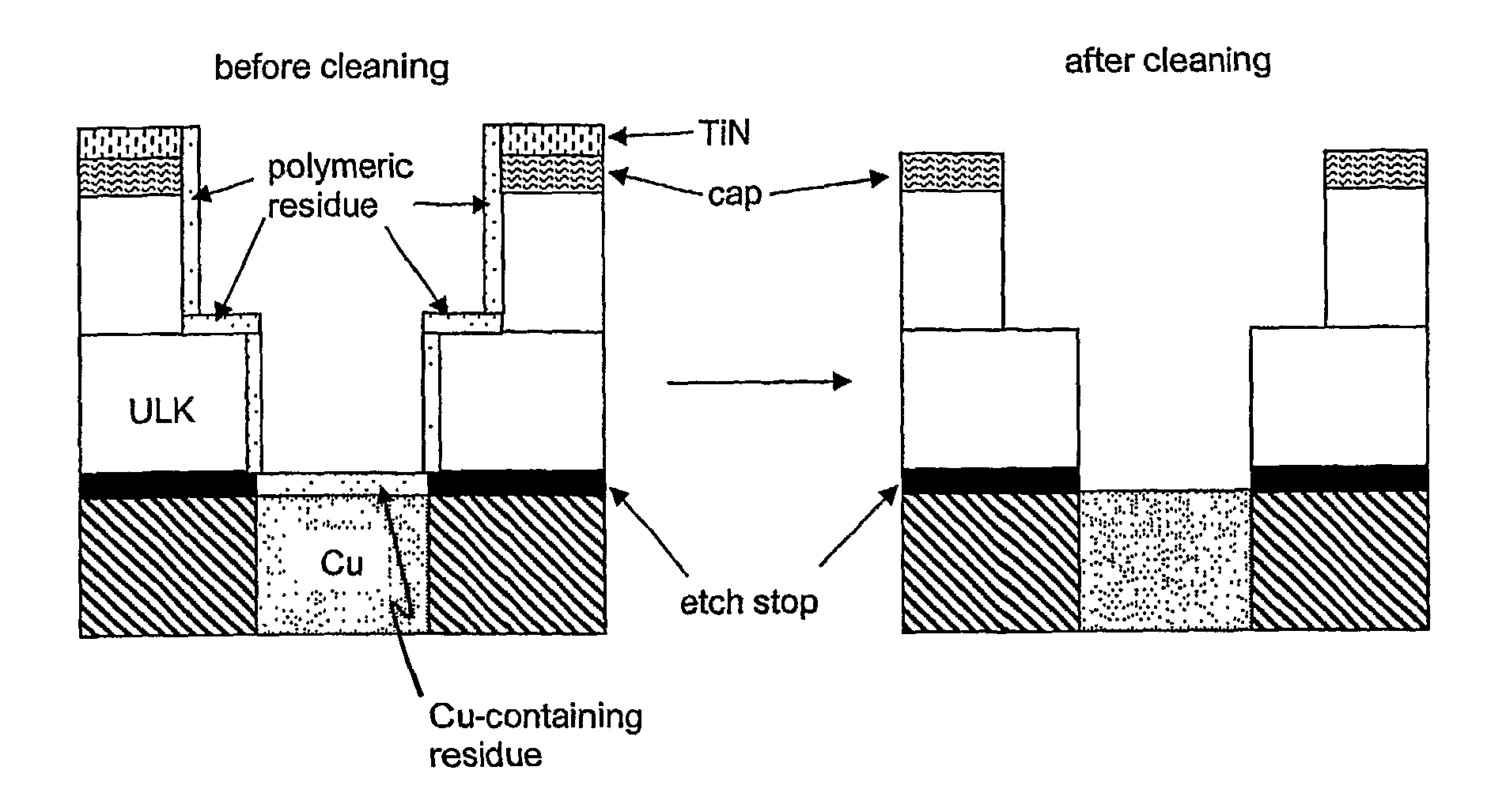Oxidizing aqueous cleaner for the removal of post-etch residues
a technology of aqueous cleaner and residue removal, which is applied in the direction of ampholytes/electroneutral surface active compounds, inorganic non-surface active detergent compositions, instruments, etc., can solve the problems of corroding metal structures, increasing the dielectric constant, and interfering with subsequent silicidation or contact formation
- Summary
- Abstract
- Description
- Claims
- Application Information
AI Technical Summary
Benefits of technology
Problems solved by technology
Method used
Image
Examples
example 1
[0091]The etch rates of blanketed titanium nitride and physical vapor deposited (PVD) copper samples in Formulations A-D was determined. The thickness of the TiN and PVD Cu coatings on silicon wafers were measured before and after immersion for 60 minutes in Formulations A-D at the indicated temperatures. Thicknesses were determined using a 4-point probe measurement whereby the resistivity of the composition is correlated to the thickness of the film remaining and the etch rate calculated therefrom. The experimental etch rates are reported in Table 1.
[0092]
TABLE 1Etch rate of TiN and PVD Cu in Å min−1after immersion in Formulations A-D.Temperature / Etch rate / Å min−1TiN / CuFormulation° C.TiNPVD CuselectivityA206.30.0790:13011.7——4018.7——B2033.30.748:1C207.70.326:1D209.616.70.58:1
[0093]It can be seen that at 20° C., Formulation A had the most favorable TiN to Cu etch selectivity. Further, the etch rate of TiN increased as the temperature increased.
example 2
[0094]A sample of low-k dielectric material consisting of a 3500 Å uniform coating of porous CDO having a nominal k-value of 2.5 on a silicon wafer was evaluated for thickness and refractive index both before and after immersion in Formulation E for 10 minutes at 40° C. The thickness and refractive index were measured using spectroscopic ellipsometry. The results are shown in Table 2 hereinbelow.
[0095]
TABLE 2Thickness and refractive index of blanketed porousCDO before and after immersion in Formulation E.pre-cleanpost-cleanchangethickness / Å32653279+14refractive index1.36931.3758+0.0065
[0096]It can be seen that the neither the thickness nor the refractive index changed significantly following immersion of the porous CDO in Formulation E. This suggests that the CDO was not substantially etched, which is indicative of negligible change in the dielectric constant.
[0097]Referring to FIG. 2, which is the Fourier Transform Infrared (FTIR) Spectrograph of the porous CDO sample before and af...
example 3
[0099]The bath-life of Formulation E was compared to the bath-life of Formulation F by monitoring the concentration of hydrogen peroxide at 40° C. The relative H2O2 concentration was measured for a solution aliquot diluted in dilute sulfuric acid. The diluted aliquot was titrated with a solution of about 7.5 w / v % ammonium cerium (IV) sulfate hydrate in dilute sulfuric acid. The relative H2O2 concentration was determined by the volume ratio of cerium (IV) solution required to reach the end point versus the volume required at zero aging time. The results of the bath-life comparison are shown in FIG. 3. It can be seen that Formulation E, although a promising candidate for the selective and effective removal of titanium-containing post-plasma etch residues, undergoes about 50% H2O2 decomposition over less than 50 minutes, thereby decreasing the efficacy of said formulation for the residue material over time. In contrast, Formulation F, comprising NMMO, underwent negligible decompositio...
PUM
| Property | Measurement | Unit |
|---|---|---|
| temperatures | aaaaa | aaaaa |
| dielectric constant | aaaaa | aaaaa |
| temperatures | aaaaa | aaaaa |
Abstract
Description
Claims
Application Information
 Login to View More
Login to View More - R&D
- Intellectual Property
- Life Sciences
- Materials
- Tech Scout
- Unparalleled Data Quality
- Higher Quality Content
- 60% Fewer Hallucinations
Browse by: Latest US Patents, China's latest patents, Technical Efficacy Thesaurus, Application Domain, Technology Topic, Popular Technical Reports.
© 2025 PatSnap. All rights reserved.Legal|Privacy policy|Modern Slavery Act Transparency Statement|Sitemap|About US| Contact US: help@patsnap.com



